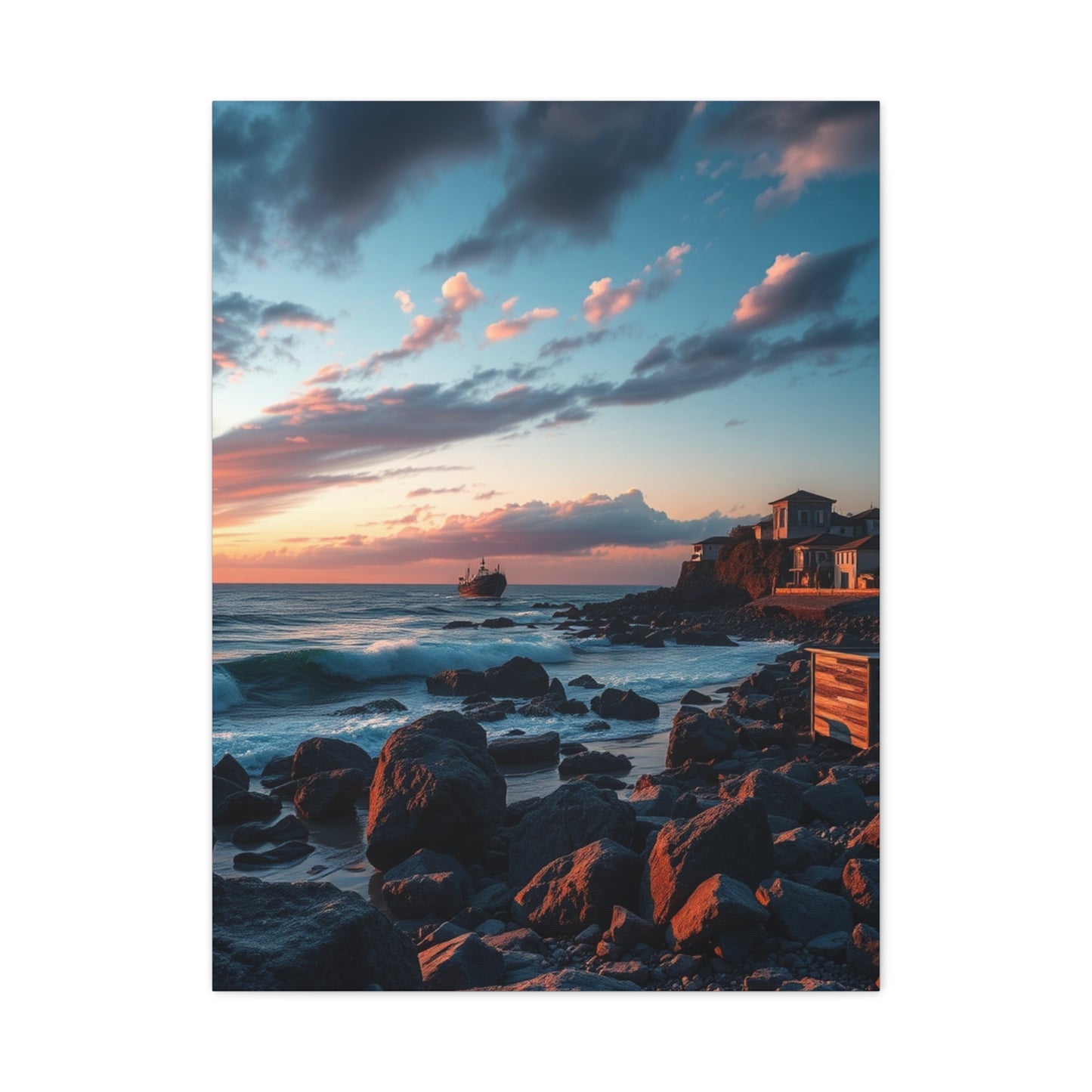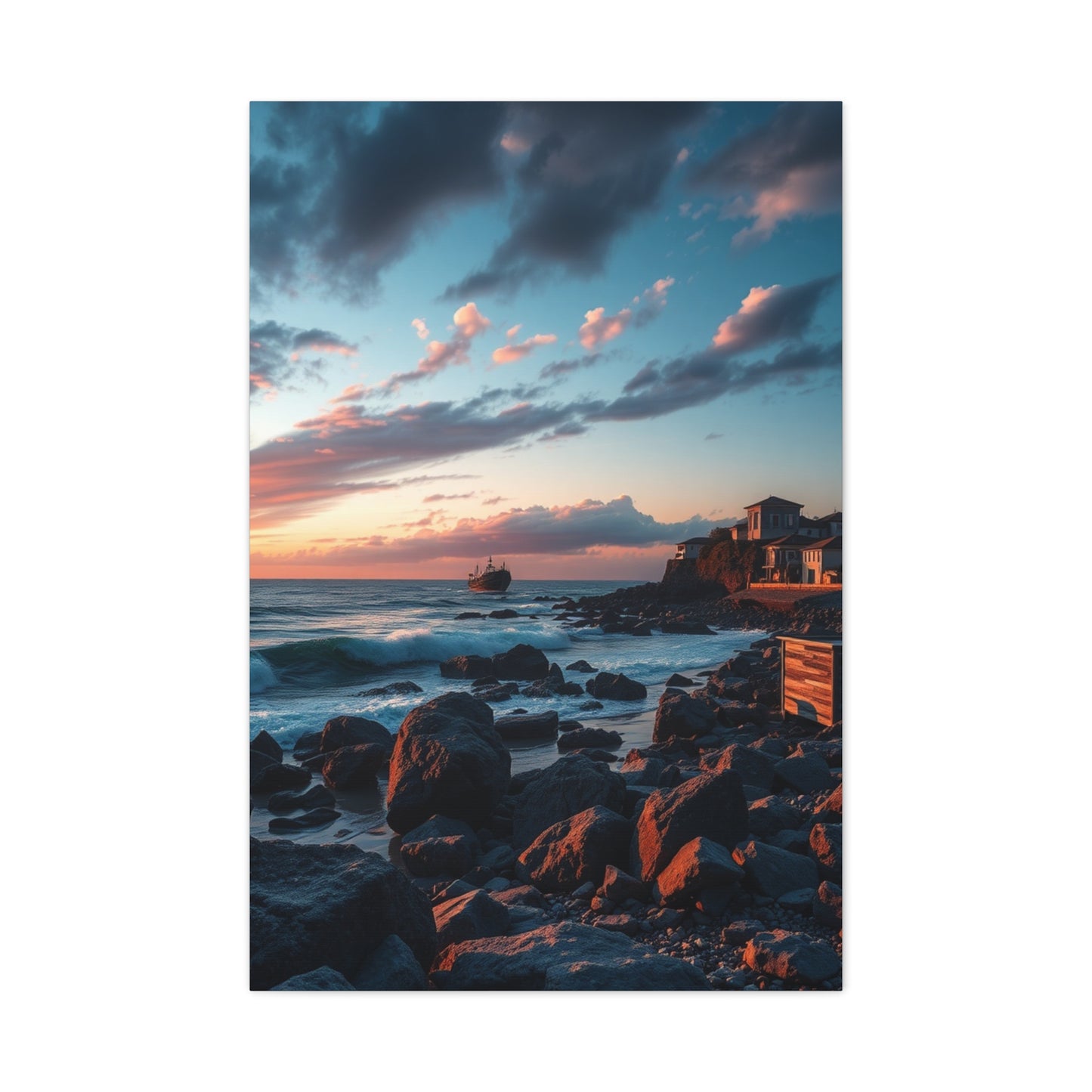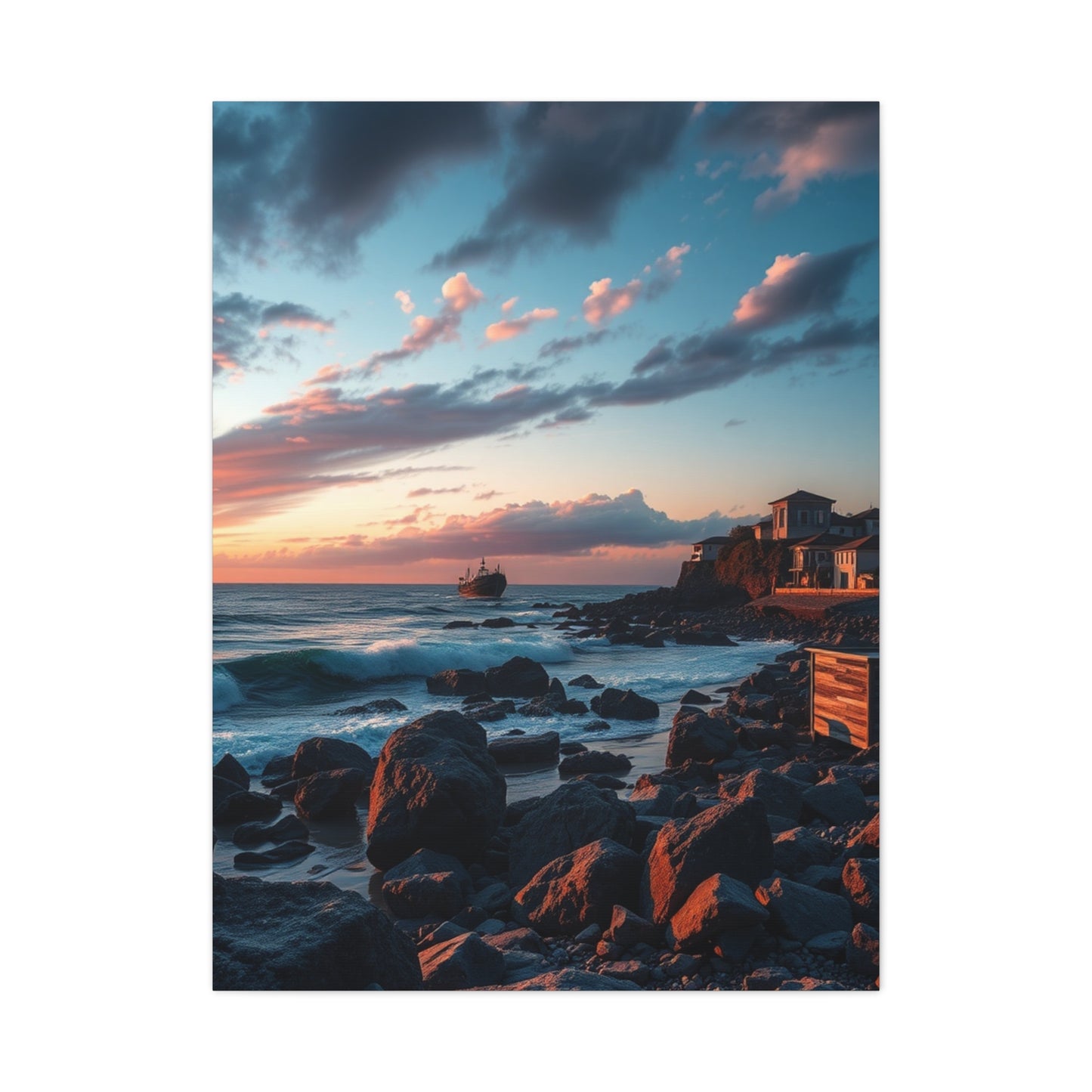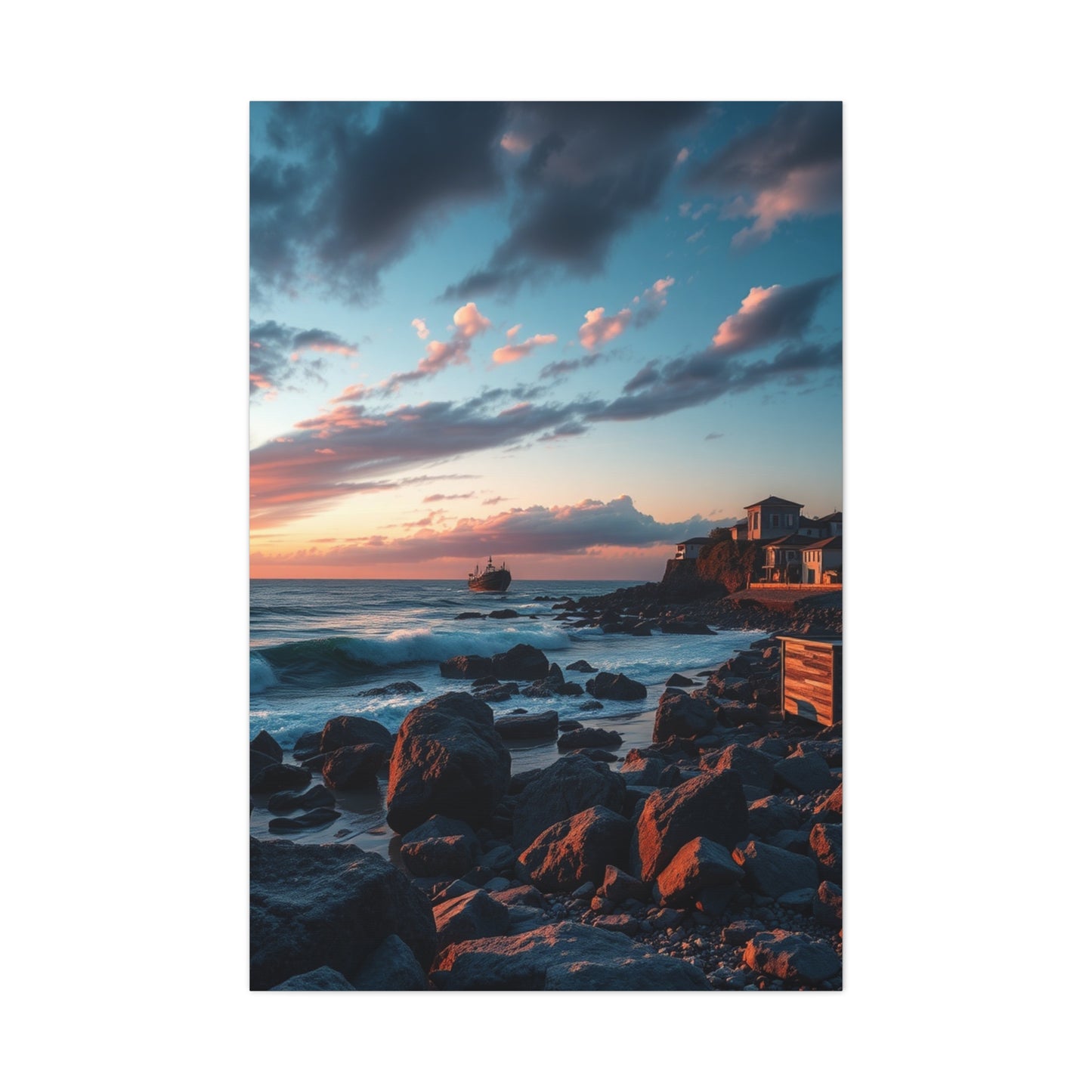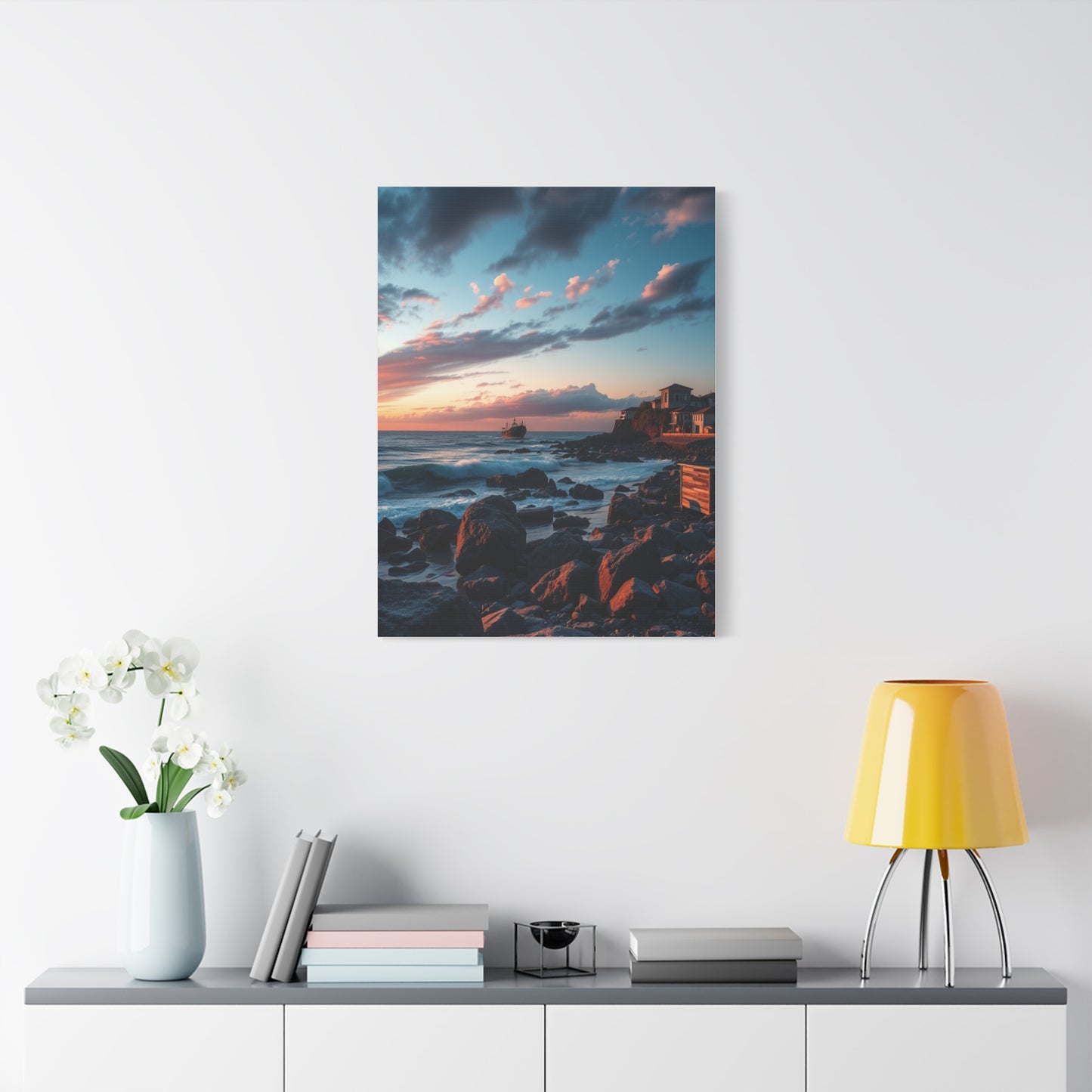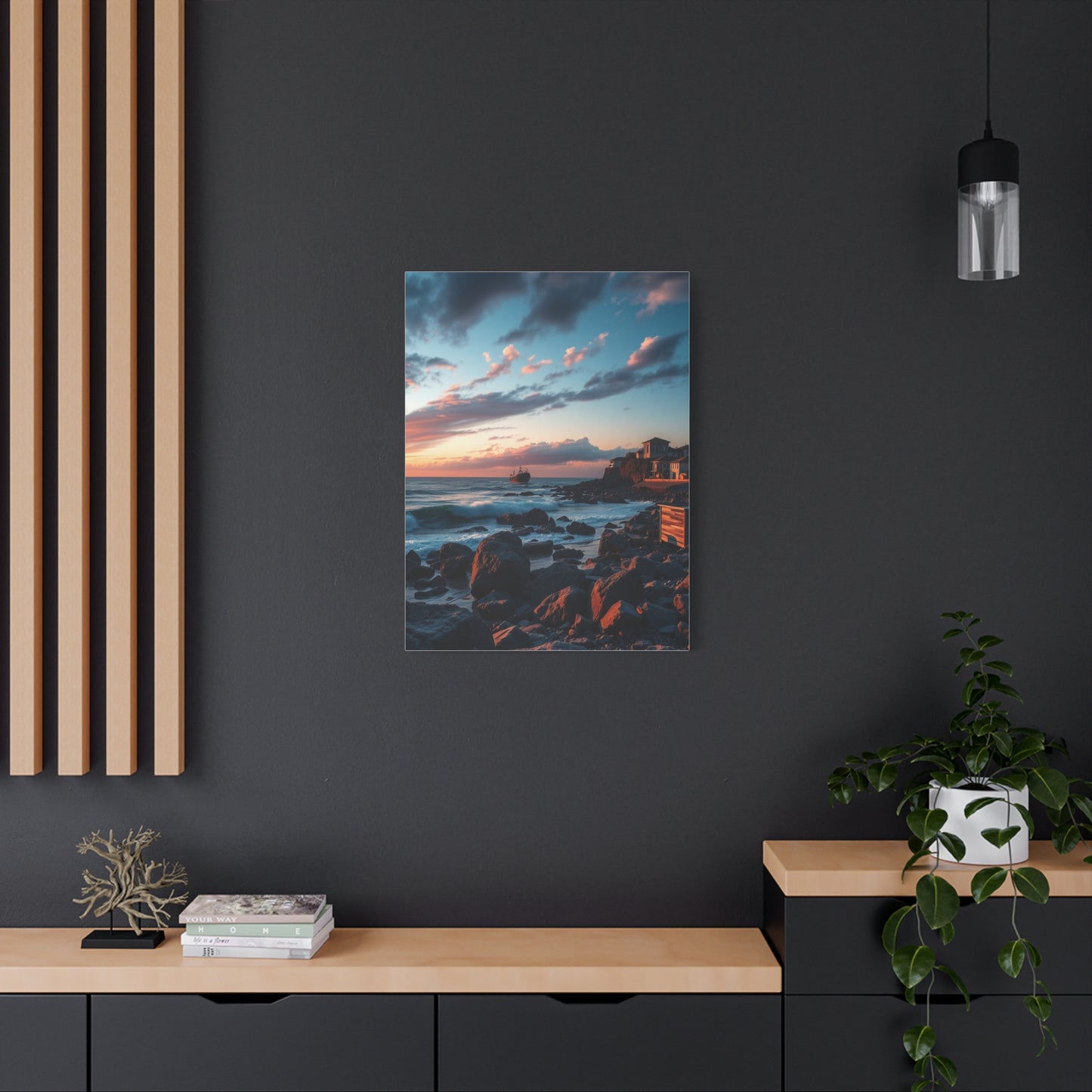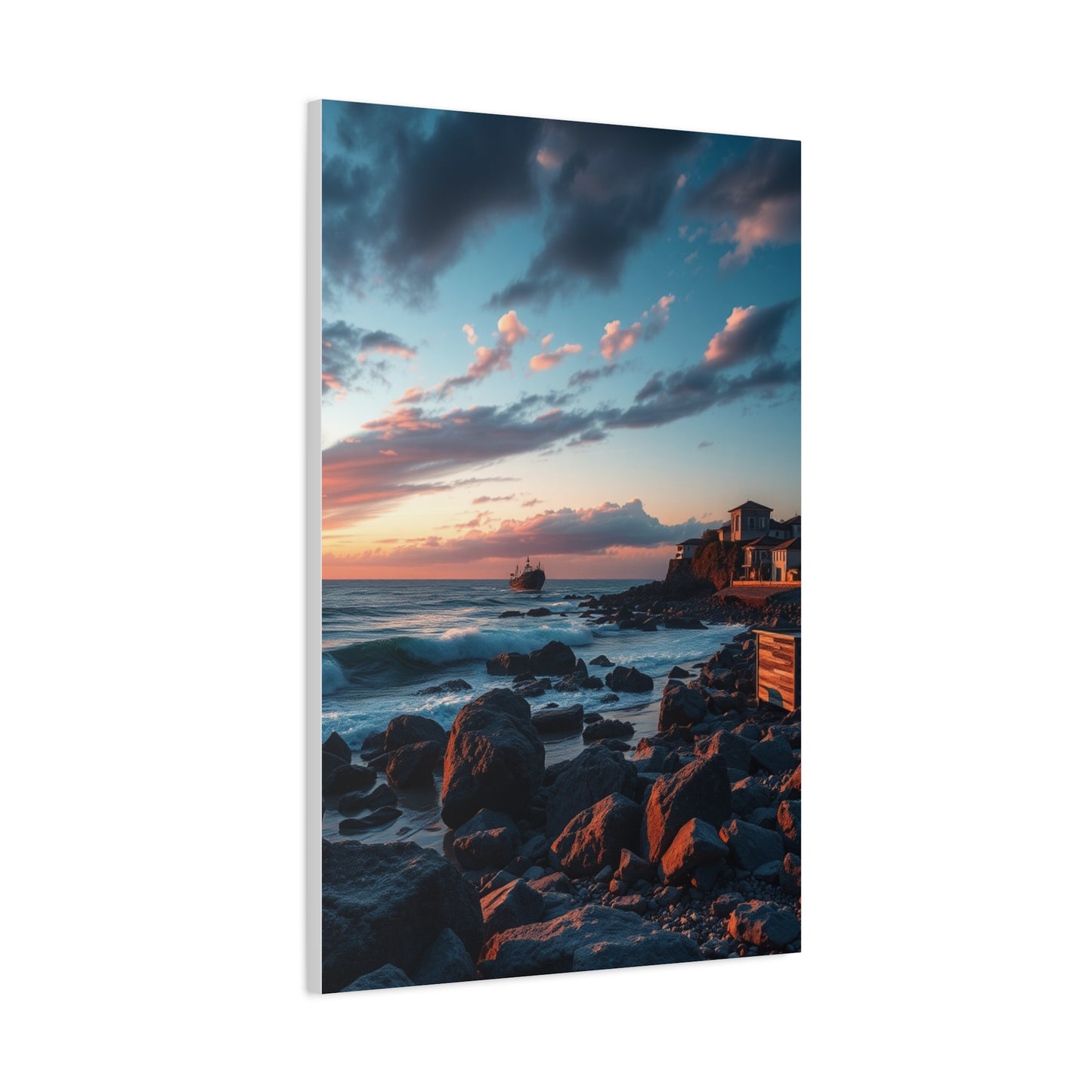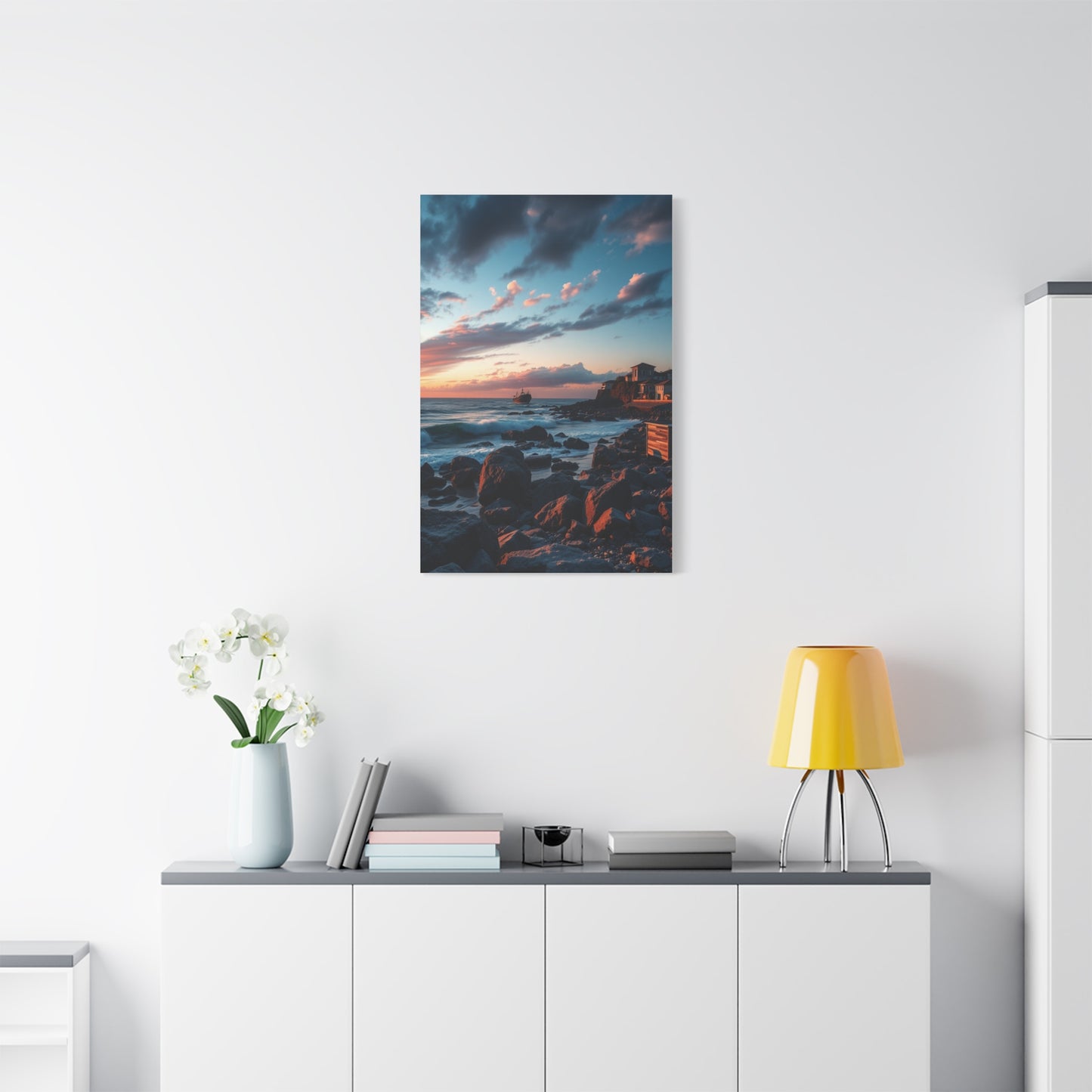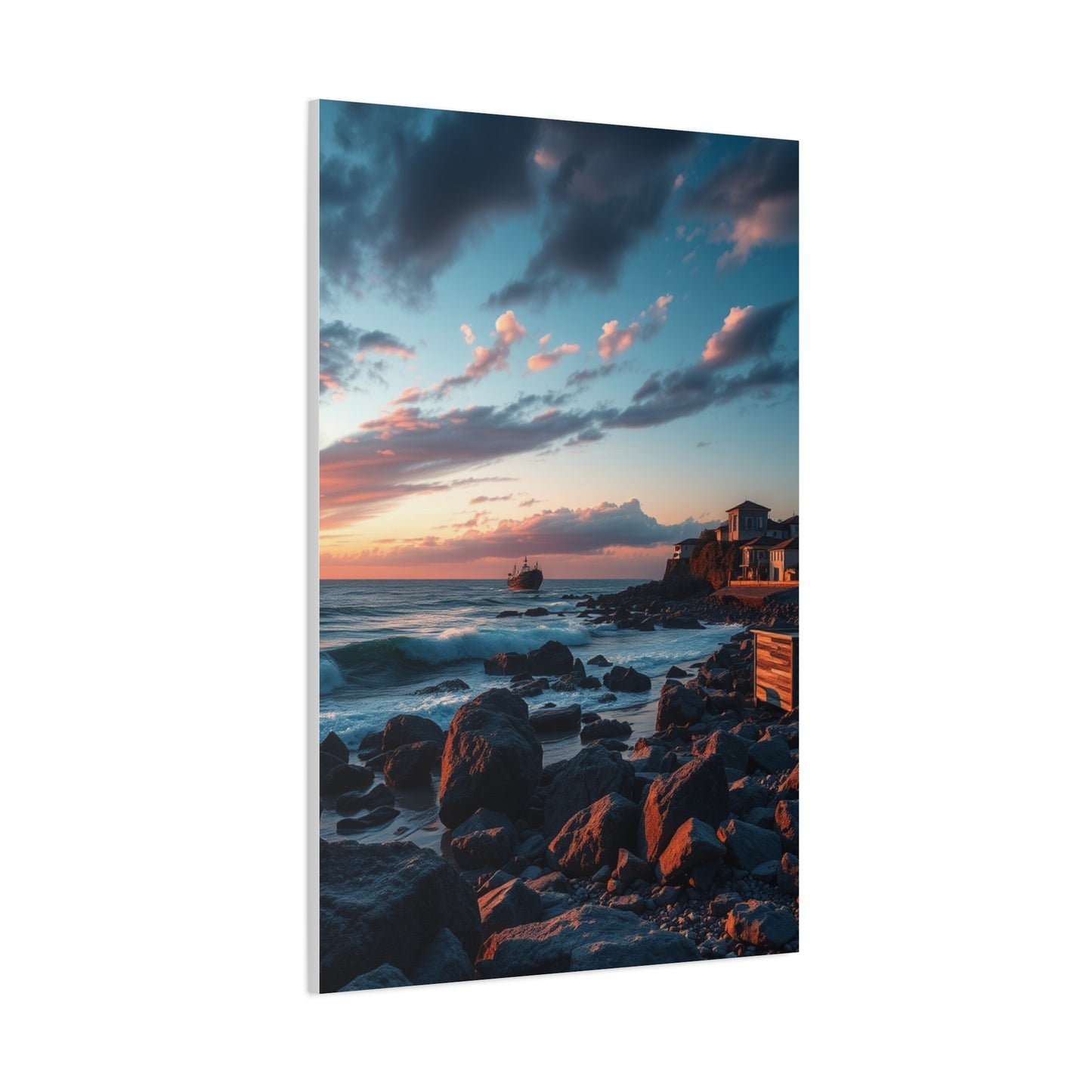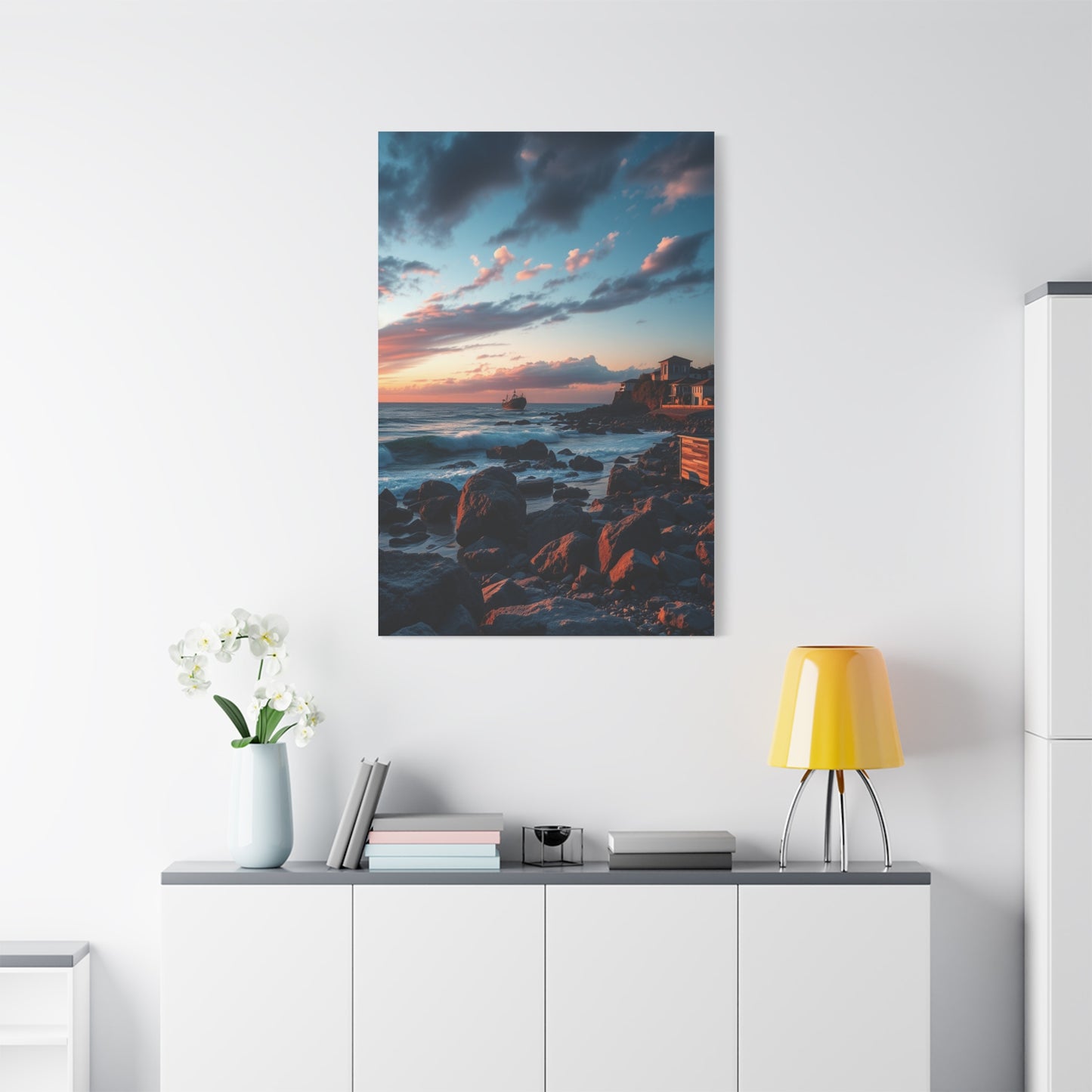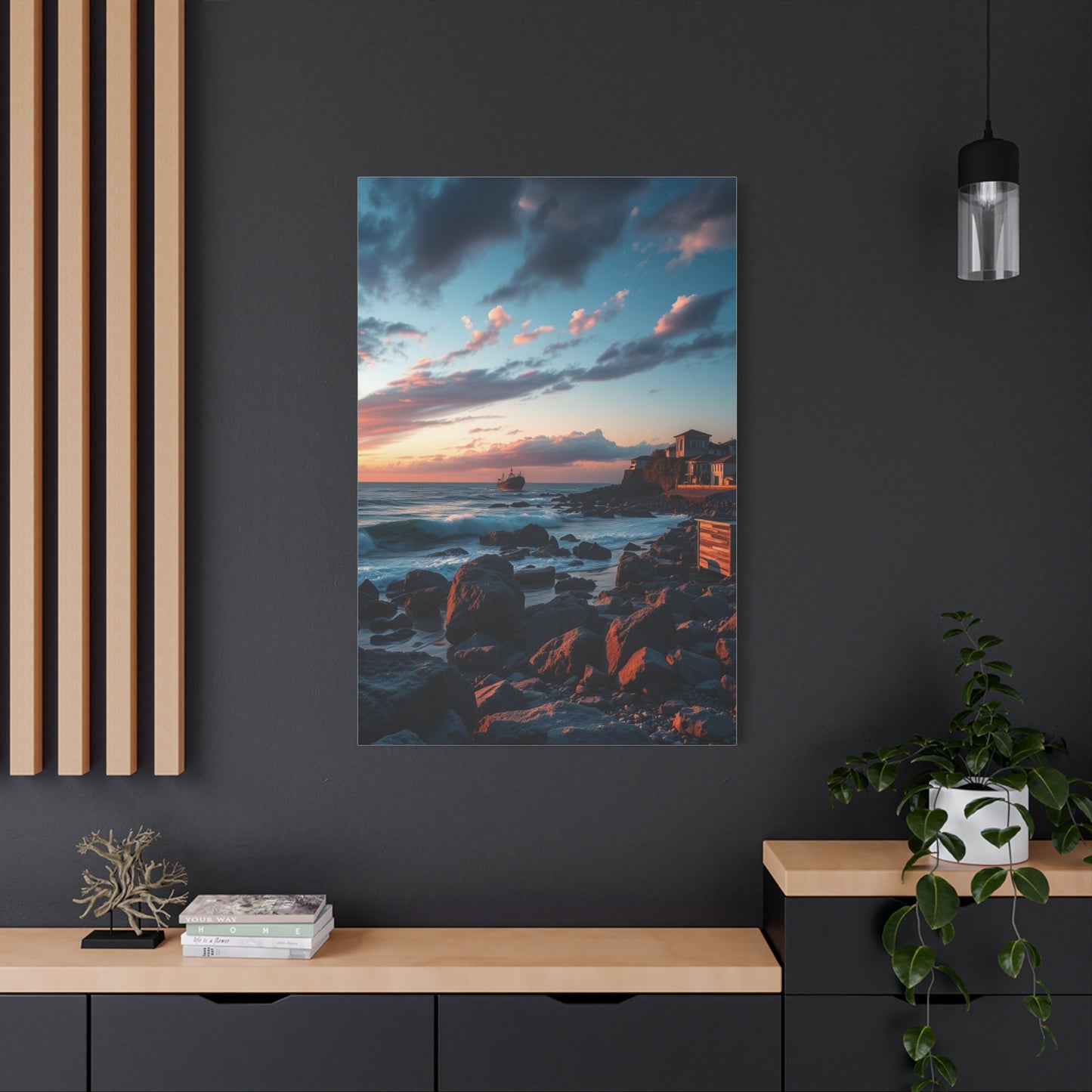Transform Your Home with Azure Horizon Panoramas Wall art: Complete Guide
The allure of expansive skies meeting distant landscapes has captivated humanity for centuries, offering a visual representation of boundless possibilities and infinite peace. When you introduce panoramic artwork featuring azure horizons into your living environment, you create an immediate connection to nature's most soothing visual elements. The experience of gazing toward a distant meeting point between earth and sky naturally calms the nervous system, reducing stress hormones and promoting mental clarity. This physiological response occurs because our brains associate open vistas with safety and freedom, triggering relaxation responses that counteract the confined feelings of modern indoor living.
Contemporary interior design increasingly recognizes the therapeutic value of incorporating natural elements into residential spaces, a concept known as biophilic design. Artwork depicting vast blue horizons serves as a powerful tool for bringing outdoor serenity indoors, especially valuable for urban dwellers with limited access to natural landscapes. The subtle gradations of azure tones found in horizon imagery mirror the color spectrum most associated with calmness in color psychology, ranging from deep oceanic blues to pale sky tints that evoke early morning tranquility.
When selecting pieces that showcase distant meeting points between sky and land or water, consider how the artwork will function as both a visual focal point and an emotional anchor within your space. The best selections feature clean compositions that avoid visual clutter, allowing the eye to travel smoothly across the expanse without interruption. This unobstructed visual journey mimics the meditative experience of actual horizon gazing, where the mind naturally settles into contemplative states.
The strategic placement of such artwork transforms ordinary rooms into sanctuaries of peace. Position these pieces where you naturally pause during daily routines, creating micro-moments of tranquility throughout your day. Morning coffee becomes a meditative ritual when enjoyed while viewing a serene skyline, and evening unwinding gains depth when accompanied by the visual embrace of endless blue vistas. The psychological impact extends beyond immediate viewing moments, as the subconscious mind continues processing the calming imagery, contributing to overall reduced anxiety levels within the home environment.
Understanding the dimensional aspects of panoramic formats enhances their effectiveness in creating peaceful atmospheres. Wide-format compositions naturally draw the eye horizontally, mimicking the way we scan actual landscapes, which feels inherently more relaxing than vertical viewing patterns. This horizontal emphasis creates perceived width in rooms, making spaces feel less confined and more connected to the expansive qualities of outdoor environments. The ratio of width to height in these pieces should ideally reflect natural viewing proportions, typically ranging from 2:1 to 3:1 ratios that best replicate actual horizon perspectives.
Lighting considerations play a crucial role in maximizing the calming effects of horizon artwork. Natural light interacting with azure tones creates dynamic viewing experiences that change throughout the day, much like actual skies shift in appearance from dawn through dusk. Position pieces where morning or afternoon light can graze across the surface, activating the blues and creating subtle shadow play that adds depth and dimension. Evening lighting should be soft and indirect, allowing the artwork to maintain its soothing presence without harsh contrasts that disrupt the peaceful atmosphere.
The material choices for these artistic pieces significantly impact their effectiveness in creating serene environments. Canvas prints offer texture that adds tactile interest while maintaining affordability, whereas metal prints provide luminous qualities that make azure tones appear to glow from within. Acrylic mounting creates depth through layering, giving the illusion of looking through a window toward distant vistas. Each material choice should align with the overall aesthetic goals of your space while enhancing the inherent calming properties of the imagery itself.
The Beauty of Panoramic Azure Horizon Art
Panoramic compositions featuring azure horizons possess unique aesthetic qualities that distinguish them from other decorative art forms, combining technical precision with emotional resonance. The elongated format creates dramatic visual impact while maintaining simplicity, a paradox that makes these pieces simultaneously bold and subtle. This duality allows them to serve as statement pieces without overwhelming spaces or competing with other design elements, striking a perfect balance between presence and restraint.
The color palette centered around various shades of blue carries profound psychological significance across cultures and throughout history. Azure tones specifically evoke associations with clear skies and pristine waters, elements universally recognized as symbols of purity, peace, and contemplation. The graduated transitions from deeper blues to lighter tints within horizon imagery create visual movement that guides the eye naturally, producing a hypnotic effect similar to watching waves or clouds drift across the sky. This gentle motion within stillness captures viewer attention without demanding it, allowing the artwork to enhance environments without dominating them.
Technical considerations in creating effective panoramic horizon pieces require careful attention to composition and balance. The horizon line itself serves as a critical structural element, typically positioned according to classical proportions such as the golden ratio or rule of thirds. When the horizon sits in the lower third of the composition, emphasis falls on expansive skies that amplify feelings of openness and possibility. Conversely, horizons positioned in the upper third emphasize the grounding qualities of earth or water, creating more anchored, stable emotional responses.
The interplay between positive and negative space within these compositions contributes significantly to their beauty and effectiveness. Large areas of uninterrupted azure serve as visual resting places, giving the eye and mind permission to pause and simply exist without processing complex information. This spaciousness within the artwork translates to mental spaciousness for viewers, providing psychological breathing room that counteracts the visual noise prevalent in modern life. The absence of excessive detail becomes a design strength rather than a limitation, embodying minimalist principles that prioritize quality of experience over quantity of visual information.
Atmospheric perspective, a technique borrowed from classical landscape painting, enhances the three-dimensional quality of horizon artwork. Subtle shifts in value and saturation create the illusion of depth, with distant elements appearing lighter and less defined than foreground components. This technique taps into our innate understanding of how vision works in natural environments, making the flat surface of artwork appear to recede into convincing distant spaces. The resulting sense of depth invites viewers to mentally enter the scene, fostering imaginative escape and mental restoration.
Seasonal variations in azure tones offer diverse aesthetic options within the horizon theme. Summer skies present saturated, vibrant blues that energize spaces with their intensity, while winter horizons feature softer, more subdued tones that create contemplative moods. Transitional seasons offer unique opportunities, with spring's crisp clarity and autumn's atmospheric haze each providing distinct emotional flavors. Selecting artwork that reflects your personal seasonal preferences or choosing pieces that complement your local climate creates harmonious connections between indoor environments and the outdoor world beyond your walls.
The abstract qualities possible within horizon-inspired art expand creative possibilities while maintaining thematic coherence. Some pieces lean toward photorealistic representation, capturing specific moments with documentary precision, while others embrace impressionistic or abstract interpretations that distill the essence of horizon experiences into pure color and form. Both approaches offer validity, with realistic renditions providing recognizable anchors and abstract versions encouraging more personal, interpretive engagement. The choice between these approaches should reflect your individual aesthetic preferences and the overall design language of your space.
How Azure Horizon Art Evokes Peace and Serenity
The neurological basis for the calming effects of azure horizon imagery stems from fundamental aspects of human visual processing and evolutionary psychology. Our brains developed in environments where scanning distant horizons provided survival advantages, allowing early humans to detect approaching threats or opportunities from afar. This evolutionary heritage means that viewing expansive vistas triggers a complex cascade of neurological responses associated with safety, relaxation, and contemplative states. The specific color combination of blue tones further enhances these effects, as blue light wavelengths have been scientifically demonstrated to reduce blood pressure and heart rate while promoting melatonin production.
The phenomenon of soft fascination, identified by environmental psychologists Rachel and Stephen Kaplan, explains why horizon imagery proves so restorative without being mentally demanding. Soft fascination occurs when visual stimuli capture attention gently without requiring intense cognitive effort, allowing the mind to rest while remaining engaged. Azure horizons exemplify soft fascination perfectly, offering enough visual interest to prevent boredom while maintaining sufficient simplicity to avoid mental fatigue. This balanced engagement facilitates the restorative processes necessary for stress recovery and attention restoration.
Color psychology research consistently identifies blue as the most universally calming color across diverse cultures and demographics. The wavelength of blue light specifically affects the hypothalamus, the brain region responsible for regulating circadian rhythms, body temperature, and various hormonal functions. Exposure to azure tones can literally slow physiological processes, lowering respiration rates and reducing muscle tension. When incorporated into daily visual environments through artwork, these cumulative effects contribute to overall wellbeing and stress reduction.
The minimalist composition typical of effective horizon art eliminates visual complexity that can unconsciously stress the nervous system. Our brains constantly process environmental information, identifying potential threats or demands for attention. Busy, detailed imagery requires continuous cognitive effort as the brain attempts to categorize and understand multiple elements. In contrast, the elegant simplicity of a clean horizon line dividing expansive fields of color allows the visual processing system to rest, conserving mental energy and reducing cognitive load. This visual simplicity creates mental spaciousness, providing psychological relief from information-saturated modern environments.
The meditative qualities of horizon gazing translate remarkably well to two-dimensional artistic representations. The act of focusing on a distant point where sky meets earth or water naturally induces a relaxed state of awareness similar to meditation. When viewing artwork that captures this experience, similar neural pathways activate, producing measurable relaxation responses including decreased cortisol levels and increased alpha brain wave activity associated with calm alertness. Regular exposure to such imagery can train the nervous system toward baseline calmness, gradually reducing overall stress reactivity.
Symbolic and metaphorical associations with horizons contribute to their peace-inducing qualities beyond purely visual effects. Horizons represent boundaries between known and unknown, present and future, physical and infinite. This symbolic threshold carries profound psychological significance, embodying hope, possibility, and the potential for new beginnings. Artwork capturing these liminal spaces taps into deep archetypal imagery that resonates with fundamental human experiences of transition, journey, and aspiration. These unconscious associations add layers of meaning that enrich the viewing experience and deepen emotional responses.
The temporal quality embedded in horizon imagery enhances its serene character. Horizons exist in a perpetual state of becoming, constantly present yet forever unreachable, a visual paradox that mirrors contemplative philosophical concepts. This quality of eternal presence combined with infinite distance creates a timeless feeling that temporarily suspends viewers outside the demands of clock-driven daily life. Moments spent engaging with horizon art become micro-retreats from temporal pressure, offering brief respites that accumulate into significant stress relief over time.
Styling Your Space with Azure Horizon Wall Art
Integrating panoramic horizon artwork into existing interior designs requires thoughtful consideration of multiple factors including scale, placement, surrounding elements, and overall aesthetic coherence. The first critical decision involves determining the appropriate size for your specific space. Panoramic pieces achieve their greatest impact when sized proportionally to wall dimensions, typically occupying between one-half and two-thirds of the available wall width. Undersized pieces appear tentative and fail to create the immersive presence that defines effective horizon art, while oversized selections can overwhelm spaces and disrupt visual balance.
Wall color selection dramatically influences how azure horizon artwork integrates into room schemes. Neutral backgrounds including whites, grays, and beiges provide clean canvases that allow the blues in the artwork to command full attention without color competition. These neutral palettes create gallery-like environments where the art becomes the undisputed focal point. Alternatively, deeper wall colors including charcoal, navy, or even black can create dramatic contrasts that make lighter elements within the artwork pop forward, adding depth and sophistication. The key lies in ensuring that wall colors complement rather than clash with the specific blue tones present in your chosen piece.
Furniture arrangement should acknowledge and respond to horizon artwork rather than ignore or compete with it. Position seating to face or angle toward the piece, creating natural viewing opportunities during daily activities. Coffee tables, console tables, or other low furniture placed beneath the artwork provide anchoring elements that ground the composition without blocking views. Avoid placing tall furniture or busy shelving adjacent to horizon pieces, as these elements create visual competition that diminishes the calming, spacious qualities you seek to cultivate.
Layering artwork with other decorative elements requires restraint and intentionality when working with panoramic horizon pieces. These works generally function best as solo focal points rather than elements within gallery wall arrangements. If you choose to include additional pieces, select small accent works positioned at considerable distances from the main horizon piece, ensuring they complement rather than compete. Decorative objects including vases, sculptures, or plants should echo the color palette or natural themes present in the artwork, creating cohesive visual conversations across the space.
Lighting design specifically tailored to highlight horizon artwork enhances both the visual impact and the emotional atmosphere. Picture lights mounted directly to the frame or wall provide focused illumination that draws attention while creating subtle drama. Track lighting offers flexibility, allowing you to adjust beam angles and intensity to accommodate different viewing times and moods. Natural lighting should be considered carefully, as direct sunlight can cause fading over time while also creating glare that obscures viewing. Ideally, position pieces perpendicular to windows so they receive ambient light without direct exposure.
Framing choices significantly impact how horizon artwork integrates into surrounding decor. Simple, streamlined frames in black, white, or natural wood maintain focus on the imagery while providing clean definition. Float mounting, where artwork appears to hover within the frame surrounded by a mat border, adds dimensionality and sophistication. Frameless mounting options including gallery wraps or flush mounts create contemporary, minimalist presentations that emphasize the expansive qualities of horizon imagery. Frame selection should align with overall room style while avoiding ornate designs that conflict with the minimalist nature of horizon compositions.
The concept of visual breathing room proves essential when styling spaces around horizon artwork. Allow generous open wall space surrounding the piece rather than crowding it with other elements. This spaciousness mirrors the openness depicted within the artwork itself, creating harmonious relationships between art and environment. The negative space surrounding the piece becomes an active design element, contributing to the serene atmosphere rather than representing wasted area awaiting additional decoration.
Textile selections including curtains, throw pillows, and rugs offer opportunities to echo and reinforce the color palette present in azure horizon artwork. Choose fabrics featuring various shades of blue ranging from deep navy to pale sky tones, creating subtle visual connections that tie the room together. Texture variations in these textiles add tactile interest while maintaining color coherence. Natural materials including linen, cotton, and wool provide organic counterpoints to the visual smoothness typical of horizon imagery, adding dimension without disrupting the peaceful atmosphere.
Why Azure Horizon Panorama Art Works in Any Room
The universal appeal and functional versatility of panoramic azure horizon artwork stem from its unique ability to fulfill multiple design needs simultaneously while adapting to diverse spatial contexts. Unlike highly specific imagery that demands particular settings or styles, horizon-themed pieces possess sufficient abstraction and simplicity to harmonize with virtually any interior design approach. This adaptability makes them valuable investments that can transition successfully through home moves, room repurposing, and evolving aesthetic preferences.
Living rooms benefit enormously from the presence of expansive horizon artwork positioned as central focal points above sofas or fireplace mantels. These gathering spaces serve multiple functions including entertaining, relaxing, and family activities, requiring artwork that enhances rather than dictates specific moods. Horizon imagery meets this need perfectly, providing visual interest that stimulates conversation while maintaining enough subtlety to recede into the background during focused activities. The calming qualities prove especially valuable in these multi-purpose spaces, helping to decompress after work while creating welcoming atmospheres for guests.
Bedroom environments require artwork that promotes relaxation without over-stimulation, making azure horizon pieces ideal selections. The soothing blue color palette naturally prepares the mind and body for rest, while the open, expansive compositions prevent feelings of confinement that can interfere with sleep quality. Position these pieces on walls facing the bed so they provide calming focal points during the transitional periods of waking and sleeping. The simplicity of horizon imagery prevents the visual distraction that more complex artwork might create in spaces dedicated primarily to rest and restoration.
Home offices and study spaces benefit from horizon artwork's ability to reduce stress while maintaining enough visual engagement to prevent sterile, uninspiring work environments. The presence of expansive blue vistas provides mental escape valves during intense work periods, offering quick visual breaks that facilitate attention restoration without requiring physical movement away from work areas. Research indicates that brief exposures to nature imagery during work sessions improve focus, creativity, and problem-solving abilities, making horizon art functionally valuable beyond aesthetic contributions.
Dining rooms gain sophistication and serenity from properly scaled horizon pieces that enhance meal experiences without dominating conversations or food presentations. The horizontal emphasis of panoramic formats complements the linear nature of dining tables, creating visual harmony within the space. Azure tones prove particularly compatible with dining environments as they neither over-stimulate appetite nor create unpleasant associations, maintaining neutral ground that accommodates diverse culinary presentations and gathering types from casual family meals to formal entertaining.
Bathroom and spa-like environments achieve enhanced tranquility through the incorporation of horizon-inspired artwork that reinforces the water associations already present in these spaces. The connection between azure blues and aquatic environments creates intuitive thematic coherence that elevates ordinary bathrooms into restorative retreats. Consider pieces that emphasize the meeting of water and sky rather than land-based horizons to strengthen these associations. Ensure that artwork in these environments receives proper protection from moisture through appropriate framing and placement away from direct water exposure.
Hallways and transitional spaces often receive minimal decorative attention despite offering valuable opportunities to extend cohesive design throughout homes. Narrow, elongated corridors provide ideal proportions for panoramic horizon pieces, with the horizontal emphasis creating visual width that counteracts the tunnel-like feeling common in these spaces. The calming influence of horizon imagery in these pass-through areas creates seamless transitions between rooms, maintaining peaceful atmospheres throughout the home rather than limiting serenity to specific destination rooms.
Commercial and professional environments including waiting rooms, lobbies, and corporate offices increasingly recognize the value of horizon artwork in creating welcoming, stress-reducing atmospheres. Medical facilities particularly benefit from imagery proven to reduce patient anxiety, while corporate settings use horizon pieces to communicate values of vision, clarity, and expansive thinking. The professional, sophisticated appearance of well-executed horizon art maintains appropriate gravitas for business environments while humanizing potentially austere spaces.
Multi-generational households find common ground in horizon artwork that appeals across age ranges and personal preferences. Children respond positively to the open, hopeful qualities of horizon imagery without requiring sophisticated aesthetic understanding, while adults appreciate the nuanced execution and calming properties. This cross-generational appeal makes horizon pieces safe choices for shared family spaces where diverse preferences must coexist harmoniously.
The Calming Effect of Horizon-Inspired Wall Art
Scientific research into environmental psychology and neuroscience increasingly validates the therapeutic effects of exposure to horizon imagery, both in natural settings and through artistic representations. Studies conducted at attention restoration laboratories demonstrate that participants viewing expansive natural scenes including horizons show measurable decreases in blood pressure, heart rate variability, and muscle tension compared to control groups viewing urban environments or remaining in neutral conditions. These physiological changes correspond with self-reported improvements in mood, anxiety levels, and perceived stress.
The mechanisms underlying these calming effects involve multiple interconnected systems within the brain and body. Visual processing of horizon lines activates neural pathways associated with spatial orientation and environmental assessment, functions that evolved to help humans navigate landscapes efficiently. When these systems detect open, unobstructed views suggesting safety and abundant resources, they signal the autonomic nervous system to downregulate stress responses. This process occurs largely outside conscious awareness, making horizon imagery a powerful tool for ambient stress reduction that works without requiring active engagement or effort.
Chromatic qualities specific to azure tones contribute independently to the calming effects beyond the compositional elements of horizon lines. Blue wavelengths penetrate deeply into eye tissues, affecting photoreceptive cells that connect directly to brain regions governing circadian rhythms and emotional regulation. Exposure to blue tones during daytime hours promotes alertness and focus while simultaneously maintaining calm baseline states, a combination that proves ideal for productive yet peaceful living and working environments. Evening exposure to warmer-toned horizon pieces supports natural transitions toward rest by avoiding the alertness-promoting effects of bright blue light before sleep.
Contrast ratios between sky and land or water elements within horizon compositions influence their calming potency. Soft, graduated transitions create the most soothing effects by avoiding harsh visual interruptions that can trigger subtle stress responses. The most effective pieces feature gentle gradations where colors blend imperceptibly, mimicking the atmospheric scattering that creates naturally soft horizon appearances in real landscapes. This visual softness translates directly to psychological softness, creating permissive, non-demanding viewing experiences that allow complete mental relaxation.
The absence of human figures, structures, or obvious signs of civilization in horizon artwork enhances its calming properties by eliminating social elements that unconsciously activate social processing regions of the brain. Pure landscape compositions allow viewers to experience nature without the cognitive demands of interpreting human presence, intentions, or potential interactions. This social silence proves particularly valuable in modern life where we navigate constant social stimulation through direct interactions, media consumption, and even urban environments densely populated with visible humanity.
Repetitive viewing of the same horizon piece throughout daily life creates familiarity that deepens calming effects rather than diminishing them through habituation. Unlike entertainment media that loses impact through repetition, ambient artwork functions as environmental conditioning, with each viewing reinforcing the relaxation response until it becomes automatic. Over time, simply entering a room containing familiar horizon art can trigger stress reduction before conscious visual engagement occurs, as the brain recognizes and responds to the environmental cue.
Individual differences in response to horizon imagery exist based on personal history, cultural background, and specific life experiences. Individuals with positive memories associated with beaches, mountains, or open landscapes typically show stronger positive responses to horizon art featuring similar settings. Conversely, those with negative associations including trauma or adverse experiences in natural environments may respond differently. Understanding these individual variations allows for personalized selections that maximize calming effects based on specific biographical factors.
The temporal dimension of viewing horizon art influences its effectiveness in promoting calm. Brief exposures lasting thirty seconds to two minutes provide immediate stress reduction suitable for quick breaks during demanding activities. Extended viewing sessions of ten to twenty minutes facilitate deeper relaxation approaching meditative states, with measurable changes in brain wave patterns indicating shifts toward alpha and theta states associated with profound rest and creativity. Structuring viewing opportunities to include both brief and extended engagements optimizes the cumulative benefits throughout daily and weekly cycles.
Azure Horizon Art: A Perfect Statement for Modern Spaces
Contemporary interior design prioritizes clean lines, uncluttered compositions, and thoughtful use of negative space, principles that align perfectly with the aesthetic character of panoramic azure horizon artwork. The minimalist philosophy underlying modern design seeks to create environments that feel spacious, calm, and intentionally curated rather than accidentally accumulated. Horizon pieces embody these values through their elegant simplicity and purposeful restraint, making them ideal centerpieces for spaces embracing modern and contemporary design languages.
The color palette dominating modern interiors typically features neutral foundations punctuated by carefully selected accent colors. Azure horizon artwork provides ideal accent opportunities, introducing color interest while maintaining the sophisticated restraint characteristic of contemporary aesthetics. The range of blues present in quality horizon pieces offers sufficient variation to prevent monotony while staying within a unified color family that avoids the visual chaos of multi-hued compositions. This controlled color approach supports modern design's emphasis on cohesion and intentionality.
Material innovation within modern furniture and architectural elements finds complementary expression in the diverse presentation options available for horizon artwork. Metal prints featuring high-gloss or matte finishes echo the industrial materials common in modern furniture including steel, chrome, and brushed metals. Acrylic mounting creates the transparent, light-interactive qualities that modern design celebrates in materials like glass and lucite. These material connections create subtle dialogues between artwork and surrounding elements, enhancing the sense of unified design vision.
Geometric precision underlying modern design finds resonance in the clean horizontal lines defining horizon compositions. The mathematical clarity of the horizon as a dividing element appeals to the same aesthetic sensibilities that appreciate the precise angles and calculated proportions prevalent in modern architecture and furniture. This geometric sympathy allows horizon art to feel like natural extensions of modern spaces rather than imported elements from incompatible design traditions.
The statement-making qualities of large-scale panoramic horizon pieces satisfy modern design's preference for bold, confident design choices over timid, tentative selections. Modern aesthetics reject the notion that walls should be filled with numerous small items, instead advocating for fewer, more impactful pieces that command attention and respect. A properly sized horizon panorama fulfills this role perfectly, creating visual drama through scale and simplicity rather than through complexity or ornamental excess.
Open floor plans characteristic of modern homes require artwork that functions effectively across multiple viewing distances and angles. Horizon pieces excel in these conditions, maintaining visual coherence whether viewed from adjacent seating areas or across open-concept spaces encompassing kitchen, dining, and living zones. The lack of fine detail that demands close inspection means these works communicate their essential character from any distance, making them ideal for the fluid, multi-functional spaces that define contemporary living.
Technology integration within modern homes including smart lighting, automated climate control, and entertainment systems creates visually busy environments despite clean design intentions. Horizon artwork provides visual counterbalance to this technological presence, offering organic, non-mechanical focal points that humanize spaces dominated by screens and devices. The natural subject matter reminds inhabitants of existence beyond digital realms, creating healthy psychological balance within tech-forward environments.
Sustainability concerns increasingly influencing modern design choices extend to artwork selection, where horizon pieces featuring natural subjects align with values of environmental awareness and biophilic design. Choosing horizon art signals commitment to bringing nature into living spaces even when located in urban environments distant from actual natural landscapes. This symbolic gesture carries meaning for environmentally conscious homeowners seeking to express their values through design choices.
The timeless quality of well-executed horizon imagery ensures longevity within modern spaces that may evolve through furniture updates, color palette shifts, or accessory changes. Unlike trendy artistic styles that date quickly, horizon themes maintain relevance across design generations, protecting the investment value of quality pieces. This temporal stability proves especially valuable in modern design, which despite its contemporary character aims for lasting impact rather than fleeting trendiness.
Using Azure Horizon Art to Create a Zen Atmosphere
The principles underlying Zen philosophy including simplicity, mindfulness, natural harmony, and present-moment awareness find visual expression in carefully selected azure horizon artwork. Creating genuinely Zen-inspired environments requires more than superficial aesthetic mimicry of Japanese design elements; it demands authentic commitment to the underlying values of reduction, contemplation, and connection to natural rhythms. Horizon imagery, when chosen and displayed thoughtfully, supports these deeper intentions while avoiding cultural appropriation or hollow stylistic imitation.
The Zen concept of ma, or meaningful negative space, manifests powerfully in horizon compositions where vast expanses of uninterrupted color create spatial breathing room for the eye and mind. Ma represents not emptiness but rather potentiality, the pregnant pause between elements that gives each component room to resonate and reveal its essential nature. Quality horizon pieces honor this principle by resisting the temptation to fill space, instead trusting the power of restraint and allowing blue expanses to speak through their very emptiness.
Wabi-sabi, the Zen aesthetic celebrating imperfection, impermanence, and incompleteness, finds expression in horizon artwork that embraces subtle variations, organic textures, and the suggestion of constant change inherent in sky and water subjects. Rather than seeking technically perfect renderings, wabi-sabi-influenced selections might feature visible brushstrokes, slight asymmetries, or qualities suggesting the handmade and unique. These imperfect qualities paradoxically increase rather than diminish the artwork's value by acknowledging the transient, evolving nature of all phenomena.
Meditative viewing practices transform horizon artwork from passive decoration into active spiritual practice. Dedicated daily periods spent in quiet contemplation before horizon pieces, perhaps combined with breathing exercises or seated meditation, deepen both the artwork's impact and the viewer's mindfulness capacities. The horizon line itself serves as a visual anchor similar to the breath in meditation practice, providing a returning point for wandering attention and a symbol of the present moment where earth meets sky in eternal now.
Natural materials in furniture, flooring, and architectural elements create ideal contexts for Zen-oriented horizon artwork. Woods with visible grain, stone surfaces showing geological history, and textiles woven from organic fibers establish environments where horizon pieces feel integrated rather than imposed. These material choices create holistic sensory experiences where visual, tactile, and even olfactory elements work synergistically to promote the groundedness and presence central to Zen philosophy.
Lighting designed to change gradually throughout the day mimics natural light cycles, reinforcing the connection between indoor environments and natural rhythms essential to Zen consciousness. Horizon artwork illuminated by this evolving light becomes a living presence that shifts appearance from dawn through dusk, preventing static viewing experiences and maintaining fresh engagement. This dynamic quality reminds viewers of impermanence and constant transformation, core Zen teachings that artwork can embody and transmit wordlessly.
The strategic use of silence and stillness in spaces featuring horizon art creates conditions for the deep listening and seeing that Zen practice cultivates. Minimizing visual clutter, reducing noise pollution through acoustic treatments, and establishing technology-free zones allow horizon artwork to be encountered in appropriate contexts where attention can settle fully. These environmental conditions prove as important as the artwork itself in creating authentic Zen atmospheres.
Ritualized daily interactions with horizon artwork including morning intentions set while viewing the piece, midday pause for visual rest, or evening gratitude practices transform art viewing from passive consumption into spiritual discipline. These rituals need not be complex or time-consuming; even thirty seconds of full presence before horizon imagery, practiced consistently, accumulates into significant mindfulness development over weeks and months.
The Role of Color in Azure Horizon Wall Art
Color theory principles provide essential frameworks for understanding why azure-dominated horizon artwork exerts such powerful psychological and aesthetic effects. The specific wavelengths constituting various blue hues interact with human visual systems in ways distinct from other colors, triggering unique neurological and emotional responses. Azure tones, typically defined as bright, pure blues resembling clear skies, occupy a specific position on the color spectrum that balances cool temperature with sufficient intensity to maintain visual interest without aggression.
Monochromatic color schemes built around azure blues demonstrate sophisticated color usage while maintaining simplicity that supports rather than competes with horizon compositions. Variations in value from pale, almost white blues to deep navy create visual movement and depth without introducing chromatic complexity. This approach allows for nuanced expression within constraint, embodying design principles that prioritize refinement over excess. Monochromatic azure schemes prove particularly effective in small spaces where color variety might create visual confusion, allowing the horizon artwork to establish and maintain clear chromatic leadership.
Analogous color combinations incorporating azure blues alongside neighboring spectrum colors including teals, aquas, and blue-violets create harmonious palettes that expand chromatic interest while maintaining cohesion. These closely related hues share underlying blue foundations that prevent discord while offering sufficient variation to avoid monotony. Horizon artwork featuring subtle transitions between blues and neighboring colors fits naturally within analogous schemes, providing nuanced color experiences that reward sustained viewing with discovered subtleties.
Complementary color theory, which pairs colors opposite on the color wheel, suggests orange as azure's direct complement. Strategic incorporation of warm accent colors including rust, copper, amber, and peach creates vibrant contrasts that make azure elements appear more intense and luminous. These complementary accents should be deployed sparingly in spaces featuring azure horizon art, perhaps through small decorative objects or single furniture pieces, preventing the overwhelm that results from equal proportions of complementary colors while leveraging the perceptual intensification that color contrast provides.
Color temperature significantly impacts the emotional atmosphere created by azure horizon artwork. Cool blues naturally evoke feelings of calm, clarity, and spaciousness but can feel sterile or cold when used without warm counterbalances. Introducing warm-toned natural materials including woods, leathers, and woven textiles provides necessary temperature balance, creating environments that feel both serene and inviting rather than austere. The contrast between cool visual temperatures in artwork and warm tactile temperatures in furnishings creates dynamic tension that enhances sensory engagement.
Saturation levels within azure tones dramatically affect their psychological impact and appropriate applications. Highly saturated, pure blues create energizing, stimulating effects suitable for spaces dedicated to activity and focus. Desaturated, grayish blues promote quieter, more contemplative moods appropriate for rest-focused environments. Quality horizon artwork often features saturation gradients, with more intense blues at zenith transitioning to paler, less saturated tones near horizon lines, mimicking atmospheric perspective while providing built-in variety that maintains visual interest.
Cultural associations with blue colors vary globally but generally trend positive, with blue ranking as the most universally preferred color across diverse populations. Western cultures associate blue with trustworthiness, stability, and professionalism while many Eastern traditions connect blue with immortality, spirituality, and healing. These widespread positive associations make azure horizon artwork broadly appealing across cultural contexts, minimizing risk of negative responses based on cultural color symbolism.
Temporal color associations linking blues to specific times of day influence how horizon artwork affects spaces. Pale azure tones evoke early morning or twilight, creating fresh, hopeful atmospheres suitable for beginning daily activities or quiet evening contemplation. Mid-tone blues suggest full daylight, promoting alertness and productivity. Deep blues recall night skies, supporting rest and introspection. Selecting horizon pieces with color tones matching intended room functions optimizes their psychological effectiveness.
Individual color preferences shaped by personal history, cultural background, and even personality traits influence responses to azure horizon artwork. Studies correlating personality types with color preferences suggest that individuals drawn to blues often value order, peace, and introspection. Understanding these correlations helps explain the widespread appeal of horizon art while acknowledging that minority preferences exist. Successful color implementation considers both general principles and individual circumstances.
How Azure Horizon Art Complements Minimalist Design
Minimalist design philosophy, rooted in the principle that "less is more," finds ideal artistic expression in panoramic azure horizon pieces that exemplify restraint, clarity, and essential reduction. The minimalist movement emerged from reactions against excessive decoration and visual complexity, instead celebrating functional simplicity and honest materials. Horizon artwork aligns perfectly with these values through uncluttered compositions that communicate powerfully through what they exclude as much as what they include.
The minimalist color palette typically featuring whites, grays, blacks, and limited accent colors provides ideal contexts for azure horizon art to function as primary color introduction. Against neutral backgrounds, blue tones achieve maximum impact and clarity, commanding attention without competition. This backdrop allows the subtle gradations and nuanced tones within quality horizon pieces to be fully appreciated, preventing the visual noise that occurs when complex colors compete for attention within single spaces.
Minimalist spaces prioritize quality over quantity, advocating for fewer, better-chosen elements rather than abundant lesser pieces. This principle applies directly to artwork selection, where a single exceptional horizon panorama outweighs multiple mediocre pieces in impact and appropriateness. The investment philosophy shifts from accumulation to curation, with each element earning its place through genuine contribution to the space's purpose and atmosphere. Horizon art succeeds in this demanding context through inherent quality and meaningful presence.
Functional considerations within minimalist design require that objects serve purposes beyond mere decoration. Horizon artwork fulfills multiple functions simultaneously, providing aesthetic enhancement, emotional regulation through calming effects, spatial perception manipulation through dimensional illusion, and focal point establishment that organizes visual attention. This functional multiplicity justifies its presence within minimalist spaces that reject items serving purely decorative roles.
The relationship between form and function central to minimalist philosophy extends to how horizon artwork interacts with architectural elements. Rather than existing as applied decoration independent of spatial structure, properly integrated horizon pieces engage with walls, windows, and furniture arrangements to enhance spatial experience. Positioning pieces to align with architectural features including ceiling lines, floor transitions, or window frames creates unified design where art and architecture function as integrated systems rather than separate elements.
Material honesty, another minimalist principle valuing authentic presentation of materials without disguise or excessive treatment, guides selection of display methods for horizon artwork. Frameless presentations or simple frames that allow the artwork itself to dominate honor this principle, avoiding ornate treatments that distract from essential content. Similarly, choosing artwork reproduction methods that honestly represent their technical nature, whether canvas prints, metal transfers, or photographic processes, maintains integrity within minimalist contexts.
Conclusion
In the world of interior design, few elements have the transformative power of a stunning piece of wall art. Among the many artistic styles and genres available today, Azure Horizon Panoramas Wall Art stands out for its breathtaking ability to transport viewers to serene, expansive landscapes. By blending calming hues of blue, vast sky views, and expansive horizons, this type of art creates a sense of peace and tranquility, making it the perfect addition to any space looking to evoke feelings of relaxation, escape, and natural beauty.
Throughout this guide, we’ve explored the significance of Azure Horizon Panoramas Wall Art, its impact on home decor, and how these pieces can elevate a room’s atmosphere. The serene and expansive imagery of the horizon, framed by soothing shades of azure, evokes a sense of infinite possibility, vastness, and connection with nature. Whether it’s a depiction of a calm seascape, an endless sky at sunrise, or the fading light of dusk, the inherent tranquility of the horizon in these panoramas can serve as a perfect backdrop for various living spaces.
The beauty of Azure Horizon Panoramas lies in their ability to harmonize with diverse design styles while maintaining their unique, eye-catching presence. These artworks seamlessly blend into modern, minimalist interiors with their calming color schemes, yet they also add depth and texture to more traditional or eclectic settings. Their versatility allows them to complement various color palettes, from cool blues and whites to warm neutrals and earth tones, creating a balanced and visually appealing atmosphere in any room.
One of the defining characteristics of these panoramic pieces is their ability to draw the eye toward the horizon, guiding the viewer’s gaze across the landscape. This sense of depth creates a powerful connection between the viewer and the natural world, making these artworks particularly suited for spaces that aim to foster calmness and reflection. Whether placed above a sofa in the living room, in a meditation space, or as a focal point in a bedroom, Azure Horizon Panoramas create an inviting and peaceful environment that invites both contemplation and relaxation.
For homeowners, these panoramic artworks also offer the unique benefit of enhancing the perception of space. Their wide format and sweeping vistas can make a room appear larger, more expansive, and more open, especially in smaller or more confined areas. This optical illusion not only adds visual interest but also creates a sense of escape, as though the viewer is stepping into a vast and tranquil world beyond the walls of their home.
In addition to their aesthetic value, Azure Horizon Panoramas also carry an emotional resonance. The horizon, often symbolizing hope, potential, and the journey ahead, serves as a reminder of both the vastness of the world and the infinite possibilities that lie ahead. For individuals looking to infuse their space with a sense of optimism or inspiration, these artworks provide a visual metaphor for the promise of new beginnings, exploration, and personal growth.
In the context of interior design, incorporating Azure Horizon Panoramas into your home goes beyond mere decoration; it creates an experience. It turns a space into a sanctuary—offering a retreat from the hectic pace of daily life and fostering a sense of peace and serenity. Whether placed in a bedroom, a living room, or even a home office, the gentle blues and soft hues of these panoramas can help to create a mood of calm and relaxation, making them an ideal addition to spaces where you want to unwind and recharge.
Moreover, the soothing qualities of Azure Horizon Panoramas extend beyond the visual. These artworks have the power to affect the overall atmosphere of a room, influencing mood and energy. In a living room, for example, the presence of expansive horizons can create a space conducive to connection and socializing, inviting conversation and contemplation. In a bedroom, they can help establish a peaceful environment that promotes rest and relaxation. In an office or study, these artworks can serve as a source of inspiration, providing a calming, open atmosphere that encourages focus and creativity.
Additionally, these artworks provide an excellent opportunity to engage with nature in a modern, abstract form. As urbanization continues to grow, many of us find ourselves disconnected from natural landscapes, making it all the more essential to bring the beauty of the outdoors into our living environments. Azure Horizon Panoramas offer a window to nature, allowing us to reconnect with the beauty of expansive skies and open seas without leaving the comfort of our homes.
In conclusion, Azure Horizon Panoramas Wall Art represents a perfect blend of natural beauty, tranquility, and timeless elegance. Their ability to evoke peace, expand visual space, and foster a deep emotional connection with nature makes them an ideal choice for any home. Whether you’re looking to add a calming focal point to a living room, create an inspiring atmosphere in your workspace, or establish a peaceful retreat in your bedroom, these panoramic artworks offer a transformative experience that goes beyond decoration.
By bringing the serene, expansive vistas of the horizon into your space, you not only enhance the aesthetic value of your home but also create a sanctuary that encourages relaxation, reflection, and a deeper connection with the world beyond your walls. The Azure Horizon Panoramas are more than just art—they are a journey into a peaceful, expansive world, one that invites you to breathe, unwind, and embrace the beauty of the natural world in a way that feels both modern and timeless.

















